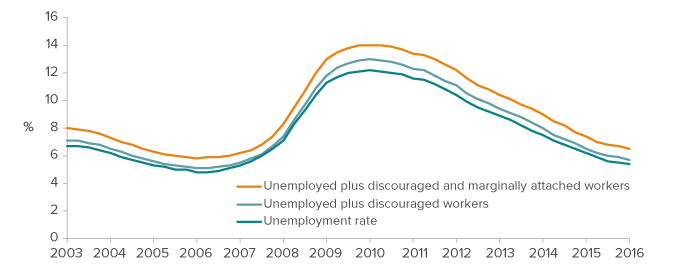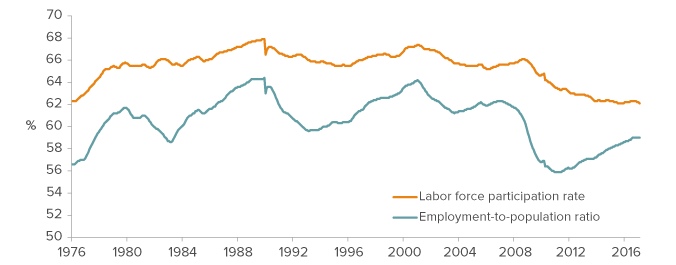- Unemployment in California is nearing long-term lows.
In February 2017, there were about 966,000 unemployed persons in California—less than half of total unemployment during the height of the recession (in October 2010). California’s 5.0% unemployment rate is also less than half the recession-era high of 12.2% and nearing the prerecession low of 4.9% (in December 2006). Although higher than the national rate of 4.7%, California’s jobless rate has been falling faster—the gap between the state and national rates narrowed from 2.9 percentage points in February 2010 to only 0.3 points in February 2017. California’s rate is the 16th highest in the country.
California’s unemployment rate is nearing prerecession levels

SOURCE: Bureau of Labor Statistics.
NOTE: Chart uses U3 (unemployment), U4 (unemployment plus discouraged workers), and U5 (unemployment plus discouraged and marginally attached workers) rates. Quarterly data shown using the preceding 12-month averages.
- Relatively few California workers are discouraged or underemployed.
People who are not in the labor force—retirees, students, and individuals who have given up looking for work—are not included in unemployment measures. When those who have stopped looking (known as “discouraged and marginally attached” workers) are factored in, the unemployment rate rises to 6.5%. The share of discouraged workers in the California labor force is now similar to prerecession levels. An additional 5.0% of the labor force may be “underemployed” (working part-time when they would rather be working full-time). But the share is roughly half what it was during the peak of the recession (9.6% in April 2010). Despite some recent improvement, California’s labor force participation rate (the share of the labor force that is either working or looking for work) remains low by historical standards, at 62.1%. Even if discouraged workers continue to reenter the labor force, the rate is likely to remain below historical levels due to the large and growing retiree population. - The California labor market appears close to full employment.
In the last six years, employment in California grew 12.7%, outstripping growth in the working-age population, which increased by 6.9%. These metrics indicate strong demand for workers and are a sign that many Californians who were unemployed or left the labor force during the recession have returned to work. The share of Californians who are working (the employment-to-population ratio) hit a historic low of 55.9% in the recession but—despite the state’s aging population—has steadily improved to 59.0%, near prerecession levels. These population measures, coupled with the low unemployment rate and increasing wages, suggest that the labor market is tightening.
Improvement in population measures suggests California’s labor market is tightening

SOURCE: Bureau of Labor Statistics.
NOTE: Based on seasonally adjusted data. The labor force participation rate is the proportion of the civilian working-age population (persons age 16 and older, who are not inmates of institutions and who are not on active duty in the Armed Forces) either working or trying to find work. The employment-to-population ratio is the proportion of the civilian working-age population that is employed.
- Unemployment differs widely and persistently across California metropolitan areas.
In February 2017, unemployment rates ranged from 2.9% (San Francisco) to 18.4% (El Centro). In fact, El Centro’s unemployment rate is by far the highest in the nation. Large, coastal metro areas—including the Bay Area (San Francisco, San Jose, Oakland, San Rafael, Napa, and Santa Rosa), Los Angeles area (Los Angeles and Oxnard/Ventura), Anaheim/Irvine, San Diego, and San Luis Obispo—currently have unemployment rates below the state’s seasonally unadjusted unemployment rate of 5.2%. Unemployment in the Sacramento area is also slightly below the state average. In contrast, many parts of the San Joaquin Valley have unemployment rates more than twice the statewide rate. These differences are persistent: metro areas with unemployment rates that were relatively high before the recession continued to have high unemployment during and after the recession. - Unemployed Californians have been out of work for a long time.
More than one-quarter of unemployed workers (26.0%) have been looking for work for six months or longer, and 16.9% have been looking for a year or longer. Although the rate of long-term unemployment has not improved dramatically from its peak in 2011, the number of long-term unemployed today is much smaller (267,000 in February 2017, compared to more than 1 million in 2011). Recessions can hamper the prospects of workers who remain unemployed for long periods.
Sources: Current Population Survey; California Employment Development Department, Labor Market Information Division; and Bureau of Labor Statistics.
Related Content
